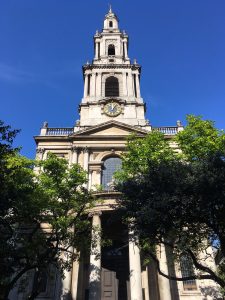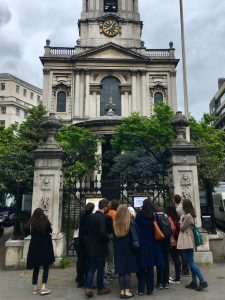Greening Aldwych Stop 6: St Mary le Strand
From India House, Montreal Place, use the traffic lights to make the crossing to the gates of St Mary le Strand, the church in the traffic island.
Or, go back to Stop 5: a Plane tree paradise?
By Clare Brant

The steeple of St Mary le Strand, a very sunny day in May 2019!
A tax on coal coming into London was levied in 1670 as a way of raising money to rebuild St Paul’s. Queen Anne revived the tax to pay for new churches: fifty were planned, but only twelve built (and five rebuilt).
St Mary le Strand was built between 1714 and 1723; designed by James Gibb, it was consecrated in 1724. Usually described as baroque, it has a mix of Ionic and Corinthian columns on the outside, and high windows to offset the street noise rumbling round either side of it.
It has some peculiar decoration (look around the front windows) which some contemporaries thought simply awful. It was to have had a column 250 feet high with a giant statue of Queen Anne on top. But she died, and the intended stone went into the steeple.
There were also to have been statues of worthies in the niches along the side, perhaps dispelling lingering memories of the site having hosted a great maypole. That was thirty feet high: it was taken down in 1644, when the Puritans banned all maypoles; another, symbolically taller one reinstalled in 1661 had rotted away by 1713. The third and last, erected near Somerset House as the new church got underway, ended up supporting a telescope at Wanstead Park.

Strandlines London History Day tour group, 30 May 2019.
Bonny Prince Charlie was said to have renounced Catholicism in this church; it is also where Charles Dickens’ parents were married.
Adam Smith said only a tax on bread was worse than a tax on coal; both were necessaries of life. The tax, incidentally, was 3 shillings on a chaldron – a dry measure, derived from cauldron.
On 27 April 1667 Pepys wrote in his diary:
"This morning I got in some coals at 23s. per chaldron, a good hearing, I thank God – having not been out to buy a coal all this dear time, that during this war poor people have been forced to give 45s., and 50s, and 3/."
Pepys took delivery of ten chaldrons of Newcastle coal on 13 September 1667, hoping to make a profit.
Newcastle coal features again later on the Strand, when coal gas illuminated the Savoy Theatre, the first of its kind. (Learn more at the National Gas Museum in Leicester) In 1815 Frederick Accum, a chemist, published A Practical Treatise on Gaslight (a book published by R. Ackermann at 101 The Strand!) Helpfully he tells us "One chaldron of Newcastle coal weighs from 2850 to upwards of 2978 lb".
That’s nearly 1300 to 1350 kg, or 1 and a third imperial tons, or a bit more for tonnes.
In our own era of carbon taxes and low emission zones, a coal tax fits well?
St Mary’s has two beautiful magnolias either side of the entrance door. They were named (in 1703) after a French botanist (by Charles Plumier – his own name went to the plumeria, or frangipani family). The name was taken up by Linnaeus in his great work Systema Naturae (1735). Magnolia is so ancient it preceded bees, so its flowers are thought to have been pollinated by beetles.
Directions to next stop: Somerset House
Use the traffic lights to make the crossing from St Mary le Strand to Somerset House. Go through the colonnade to the main Somerset House courtyard.
